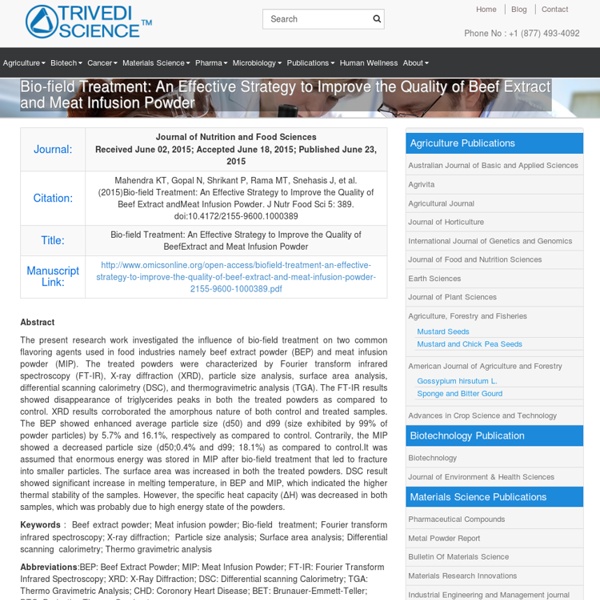Gluten Hydrolysate - Physical and Thermal Properties Modification
Abstract The objective of present study was to study the effect of biofield treatment on physical and thermal properties of gluten hydrolysate (GH) and ipomoea macroelements (IM). The study was performed in two groups (control and treated). The control group remained as untreated, and biofield treatment was given to treated group. The control and treated GH and IM were characterized by particle size analysis, surface area analysis, X-ray diffraction (XRD), Differential scanning calorimetry (DSC), and Thermogravimetric analysis (TGA). Particle size results of treated GH showed that d50 (average particle size) was decreased by 3.15% and d99 (size exhibited by 99% of powder particles) by 18.40% as compared to control GH sample.
Spectroscopic Characterization of Chloramphenicol and Tetracycline: An Impact of Biofield Treatment - Trivedi Science
Abstract Objective: Chloramphenicol and tetracycline are broad-spectrum antibiotics and widely used against variety of microbial infections. Nowadays, several microbes have acquired resistance to chloramphenicol and tetracycline. The present study was aimed to evaluate the impact of biofield treatment for spectroscopic characterization of chloramphenicol and tetracycline using FT-IR and UV-Vis spectroscopy. Methods:The study was performed in two groups (control and treatment) of each antibiotic.
Investigation of Biofield Treatment on Antimicrobial Susceptibility, Biochemical Reaction Pattern and Biotyping of Enteropathogenic Multidrug-Resistant Escherichia coli Isolates
Study background: Multidrug resistant Escherichia coli (MDR E. coli) has become a major health concern, and failure of treatment leads to huge health burden. Aim of the present study was to determine the impact of Mr. Trivedi’s biofield treatment on E. coli.
Energy Treatment Impact on Antifungal Sensitivity Assay
Abstract Fungi are the group of eukaryotic organisms such as yeast, mold, and mushrooms. The present work investigated the impact of biofield treatment on different pathogenic species of fungi in relation to antifungal sensitivity pattern. Each fungal sample was divided into three parts: C, control; T1, treatment (revived); T2 treatment (lyophilized).
Spectral Properties of Paracetamol - Biofield Energy Treatment
Abstract Paracetamol and piroxicam are non-steroidal anti-inflammatory drugs (NSAIDs), widely used in pain and inflammatory diseases. The present study aimed to evaluate the impact of biofield treatment on spectral properties of paracetamol and piroxicam. The study was performed in two groups (control and treatment) of each drug.
Impact of Biofield Treatment on Klebsiella oxytoca
Abstract Klebsiella oxytoca (K. oxytoca) is a Gram-negative microbe generally associated with community and hospitalacquired infections. Due to its clinical significance, we evaluated the effect of biofield treatment on phenotype and biotype characteristics of K. oxytoca (ATCC 43165).
"Investigation of Biofield Treatment on Antimicrobial Susceptibility, B" by Mahendra Kumar Trivedi
Mahendra Kumar Trivedi, Trivedi Global Inc. Abstract Study background: Multidrug resistant Escherichia coli (MDR E. coli) has become a major health concern, and failure of treatment leads to huge health burden. Aim of the present study was to determine the impact of Mr. Trivedi’s biofield treatment on E. coli.
Physicochemical Properties of Hydroxyethyl Cellulose
Abstract Cellulose based polymers have shown tremendous potential as drug delivery carrier for oral drug delivery system (DDS). Hydroxyethyl cellulose (HEC) and hydroxypropyl cellulose (HPC) are widely explored as excipients to improve the solubility of poorly water soluble drugs and to improve self-life of dosage form.
Magnesium XRD Analysis- Effect of Energy Treatment
Abstract Magnesium (Mg), present in every cell of all living organisms, is an essential nutrient and primarily responsible for catalytic reaction of over 300 enzymes. The aim of present study was to evaluate the effect of biofield treatment on atomic and physical properties of magnesium powder. Magnesium powder was divided into two parts denoted as control and treatment. Control part was remained as untreated and treatment part received biofield treatment. Both control and treated magnesium samples were characterized using X-ray diffraction (XRD), surface area and particle size analyzer.



